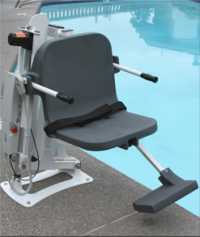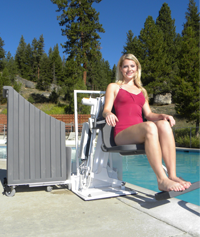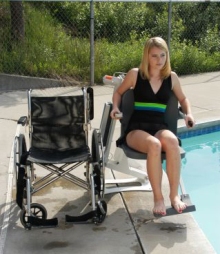Pool Lifts Frequently Asked Questions
Q: Does my pool need to be accessible?
A: Under the new 2010 changes to the ADA, any commercial pool with a perimeter less than 300 feet is required to have a sloped entry or pool lift. Any commercial pool with a perimeter exceeding 300 feet is required to have two forms of access, one of which must be a pool lift or sloped entry.
Q: What is considered to be a commercial pool?
A: Any pool that falls under Title II of the ADA, (Public entities, such as Municipal Pools), or Title III of the ADA, (Places of public accommodation, such as a hotel or fitness center pool)
Q: What pools and spas are required to be compliant?
A: Any pool or spa that is open to the public at any given time and receives any form of funding or revenue such as government funding, membership dues, and rental or usage fees. (Revised Title II Section 35.102)
Any pool or spa at a public place or commercial facility (Revised Title III Section 36.102)
Q: When am I required to make these changes by?
A: The new changes in the ADA were effective March 15th of 2011 and become mandatory by January 31st of 2013.
Q: What are some of the ways to make my pool or spa accessible?
A: There are 5 total forms of approved access; two are considered primary forms of access (Pool lift and Sloped entry). The following chart indicates what size pools need to be compliant and how.
Summary Guidelines Permitted Means of Pool Access |
|||||
| Pool Type |
Sloped Entry |
Lift |
Transfer Walls |
Transfer Systems |
Stairs |
| Swimming Pools with less than 300 linear feet of pool wall |
X |
X |
|||
| Swimming Pools with 300 or more linear feet of pool wall – 2 means of entry required |
X |
X |
X |
X |
X |
| Wave Action, Leisure River, Other Pools where user entry is limited to 1 area |
X |
X |
X |
||
| Wading Pools |
X |
||||
| Spas |
X |
X |
X |
||
Q: Are there specific technical requirements for both primary and secondary means of access for pools and spas?
A: There are specific technical requirements for both and these can be found in Section 1009 of the 2010 ADA Standards for Accessible design. These requirements indicate the technical and design requirements for all five approved forms of access.
Q: How do I know if my pool lift meets ADA requirements?
A:
• Lifting Capacity of at least 300 lbs
• A footrest must accompany the seat into the water (except for spas). A rigid seat is advised but not required
• A manually cranked or manually rotated lift is NOT ADA compliant. In order to be ADA compliant the user must be able to operate the lift without assistance
Q: What are some of the benefits of making my pool or spa ADA compliant?
A:
• Increased revenue through additional marketing opportunities – The Disabled population in the United States is the largest minority group with over 55 million individuals and over 200 billion in spending capability.
• The US government offers tax incentives for companies that remove barriers in order to make facilities more accessible and usable by individuals with disabilities. These incentives can potentially help cover the costs of modifications.
• Minimize the risk of a law suit – Any disabled individual who is unable to access your pool or spa has the right to file a complaint with the Department of Justice. If the department of justice deems it necessary, they can file a lawsuit requiring you to make your facility accessible and have the ability to levy fines of up to $110,000.
Recommendation:
If you have any further questions or seek additional information, please refer to the 2010 changes to the ADA:
Download the updated ADA Guidelines for Public Swimming Pools: ADA Revised Requirements – Accessible Pools (PDF)
Call us toll free at 800-876-7267 to discuss your specific needs





